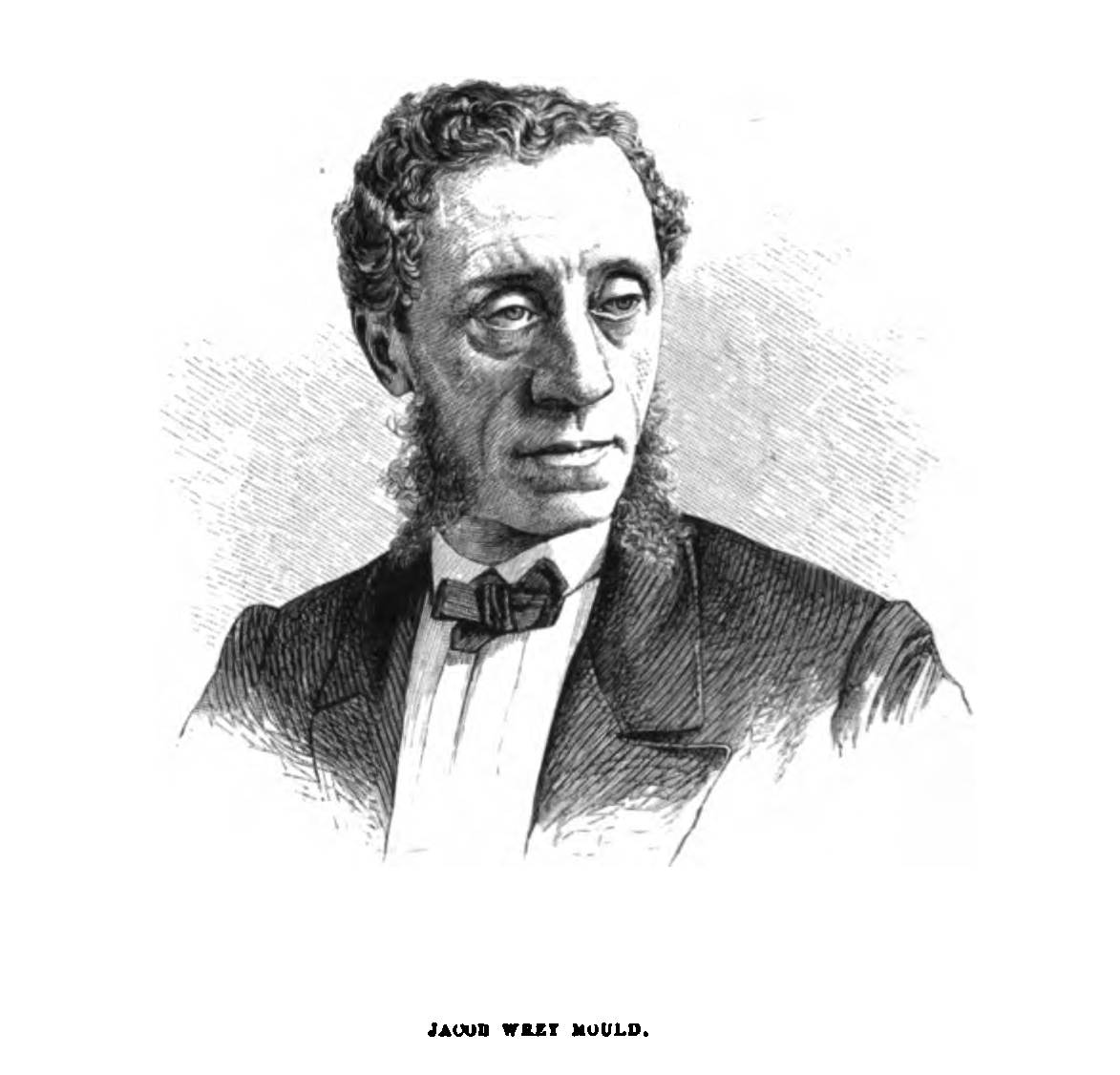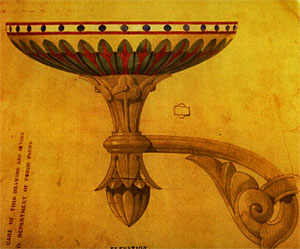Jacob Wrey Mould on:
[Wikipedia]
[Google]
[Amazon]
 Jacob Wrey Mould (7 August 1825 – 14 June 1886)
Jacob Wrey Mould (7 August 1825 – 14 June 1886)
/ref> was a British architect, illustrator,
 Born in Chislehurst, Kent in 1825, Mould attended
Born in Chislehurst, Kent in 1825, Mould attended
/ref> Besides being an accomplished architect and designer, Jacob Wrey Mould was an avid pianist and organist, and employed his talent for language in translating numerous foreign opera librettos into English.James Stevens Curl (2006) ''A Dictionary of Architecture and Landscape Architecture'', Oxford University Press, Oxford Reference Online. He is interred at
 Jacob Wrey Mould (7 August 1825 – 14 June 1886)
Jacob Wrey Mould (7 August 1825 – 14 June 1886)/ref> was a British architect, illustrator,
linguist
Linguistics is the scientific study of human language. It is called a scientific study because it entails a comprehensive, systematic, objective, and precise analysis of all aspects of language, particularly its nature and structure. Linguis ...
and musician, noted for his contributions to the design and construction of New York City's Central Park
Central Park is an urban park in New York City located between the Upper West and Upper East Sides of Manhattan. It is the fifth-largest park in the city, covering . It is the most visited urban park in the United States, with an estimated ...
. He was "instrumental" in bringing the British High Victorian architecture
High may refer to:
Science and technology
* Height
* High (atmospheric), a high-pressure area
* High (computability), a quality of a Turing degree, in computability theory
* High (tectonics), in geology an area where relative tectonic uplift to ...
to the United States, and was a founding member of the American Institute of Architects
The American Institute of Architects (AIA) is a professional organization for architects in the United States. Headquartered in Washington, D.C., the AIA offers education, government advocacy, community redevelopment, and public outreach to su ...
.
Biography
 Born in Chislehurst, Kent in 1825, Mould attended
Born in Chislehurst, Kent in 1825, Mould attended King's College School
King's College School, also known as Wimbledon, KCS, King's and KCS Wimbledon, is a public school in Wimbledon, southwest London, England. The school was founded in 1829 by King George IV, as the junior department of King's College London an ...
in 1842. For two years, he studied the Alhambra in Spain under Owen Jones
Owen Jones (born 8 August 1984) is a British newspaper columnist, political commentator, journalist, author, and left-wing activist. He writes a column for ''The Guardian'' and contributes to the ''New Statesman'' and '' Tribune.'' He has two ...
, the "master of polychromy," with whom he later co-designed the "Turkish Chamber" of Buckingham Palace. Mould's subsequent designs were often influenced by his appreciation of the Moorish style of architecture.
Mould designed decorations for The Great Exhibition
The Great Exhibition of the Works of Industry of All Nations, also known as the Great Exhibition or the Crystal Palace Exhibition (in reference to the temporary structure in which it was held), was an international exhibition which took p ...
in London in 1851. He moved to the United States in 1852, and worked on the Crystal Palace
Crystal Palace may refer to:
Places Canada
* Crystal Palace Complex (Dieppe), a former amusement park now a shopping complex in Dieppe, New Brunswick
* Crystal Palace Barracks, London, Ontario
* Crystal Palace (Montreal), an exhibition building ...
Exhibition in Manhattan
Manhattan (), known regionally as the City, is the most densely populated and geographically smallest of the five boroughs of New York City. The borough is also coextensive with New York County, one of the original counties of the U.S. state ...
. He was invited by Moses H. Grinnell in 1853 to design and build Unitarian Church of All Souls
The Unitarian Church of All Souls at 1157 Lexington Avenue at East 80th Street in the Upper East Side of Manhattan, New York City was built in 1932 and was designed by Hobart Upjohn – Richard Upjohn's grandson – in the Neo-colonial ...
, and then was brought in on early plans for the great urban park in the heart of the city, Central Park. Working closely with creators Calvert Vaux
Calvert Vaux (; December 20, 1824 – November 19, 1895) was an English-American architect and landscape designer, best known as the co-designer, along with his protégé and junior partner Frederick Law Olmsted, of what would become New York Ci ...
and Frederick Law Olmsted
Frederick Law Olmsted (April 26, 1822August 28, 1903) was an American landscape architect, journalist, social critic, and public administrator. He is considered to be the father of landscape architecture in the USA. Olmsted was famous for co ...
, he designed many of the park's notable landmarks, including the "graceful" and "richly decorated" old Bandstand, Belvedere Castle
Belvedere Castle is a folly in Central Park in Manhattan, New York City. It contains exhibit rooms, an observation deck, and since 1919 has housed Central Park’s official weather station.
Belvedere Castle was designed by Calvert Vaux and Jac ...
, a great number of bridges, and the carvings on the Bethesda Terrace
Terrace may refer to:
Landforms and construction
* Fluvial terrace, a natural, flat surface that borders and lies above the floodplain of a stream or river
* Terrace, a street suffix
* Terrace, the portion of a lot between the public sidewalk an ...
.
Though described as eccentric and ill-mannered, Mould was hired full-time as an assistant city architect in 1857, and from 1870 to 1871 was architect-in-chief for the Department of Public Works
This list indicates government departments in various countries dedicated to public works or infrastructure.
See also
* Public works
* Ministry or Board of Public Works, the imperial Chinese ministry overseeing public projects from the Tang ...
. In the 1860s, he had also built two notable country homes in Long Island on Hempstead Bay, both of which were lavish and ornate buildings for rich clients from New York. Mould also collaborated with Vaux on the design of the original Metropolitan Museum of Art
The Metropolitan Museum of Art of New York City, colloquially "the Met", is the largest art museum in the Americas. Its permanent collection contains over two million works, divided among 17 curatorial departments. The main building at 1000 ...
and the American Museum of Natural History, and designed the fountain at City Hall Park (1871).
Mould's reputation was severely damaged in 1861 when it became public knowledge that he was living with a woman who was not his wife. Many of his friends stopped associating with him, including well-known lawyer and civic leader George Templeton Strong
George Templeton Strong (January 26, 1820 – July 21, 1875) was an American lawyer, musician and diarist. His 2,250-page diary, discovered in the 1930s, provides a striking personal account of life in the 19th century, especially during the eve ...
. Despite facing rejection from his old social circles, Strong and others tempered their criticism of Mould's character with acknowledgements of his artistic talent. Fortunately for Mould, the scandal did not damage his professional relationships with Olmsted or Vaux.
In 1874, Mould went to Lima, Peru, with Henry Meiggs
Henry Meiggs (July 7, 1811 – September 30, 1877), was a promotor/entrepreneur and railroad builder born in Boston, Massachusetts
Business career
Lumber
Meiggs came to New York City in 1835 and began a lumber business that was ruined by the ...
, where he helped design a public park. He returned to New York in 1879, and resumed his duties for the Department of Public Works until his death in New York City on 14 June 1886. He built the Morningside Park promenade
An esplanade or promenade is a long, open, level area, usually next to a river or large body of water, where people may walk. The historical definition of ''esplanade'' was a large, open, level area outside fortress or city walls to provide cl ...
in 1883, and his final design in the United States was a temporary tomb for President Ulysses S. Grant
Ulysses S. Grant (born Hiram Ulysses Grant ; April 27, 1822July 23, 1885) was an American military officer and politician who served as the 18th president of the United States from 1869 to 1877. As Commanding General, he led the Union Ar ...
in Riverside Park, replaced later by the permanent monument known as Grant's Tomb.'' Appletons' Cyclopaedia of American Biography'', Vol. 4, pg 445, Digitized by Googl/ref> Besides being an accomplished architect and designer, Jacob Wrey Mould was an avid pianist and organist, and employed his talent for language in translating numerous foreign opera librettos into English.James Stevens Curl (2006) ''A Dictionary of Architecture and Landscape Architecture'', Oxford University Press, Oxford Reference Online. He is interred at
Green-Wood Cemetery
Green-Wood Cemetery is a cemetery in the western portion of Brooklyn, New York City. The cemetery is located between South Slope/ Greenwood Heights, Park Slope, Windsor Terrace, Borough Park, Kensington, and Sunset Park, and lies several blo ...
in Brooklyn
Brooklyn () is a borough of New York City, coextensive with Kings County, in the U.S. state of New York. Kings County is the most populous county in the State of New York, and the second-most densely populated county in the United States, be ...
, New York.
References
External sourcesBlog entry on Mould's translations, with a list of works.
{{DEFAULTSORT:Mould, Jacob
1825 births
1886 deaths
People educated at King's College School, London
People from Chislehurst
Architecture in England
Founder of American Institute of Architects
19th-century American architects
Burials at Green-Wood Cemetery
British emigrants to the United States